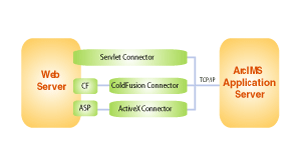ArcUser Online
 |
The AppServerLink is a conduit that allows a Java application to send ArcXML requests to the ArcIMS Application Server. It can be used with a Java application, a Java applet embedded in a Web site, or a Web site built using JavaServer Pages (JSP). Servlet ConnectorA Servlet is a Java application that runs on the server. In order for the Servlet to work, a valid Servlet Engine is needed. Some Web servers have native Servlet Engines. Web servers that do not have a native Servlet Engine require a third party Servlet Engine. Servlet Connector Web sites can use almost any combination of Web server and viewer. ArcIMS Designer can be used to create Web sites for the Servlet Connector, and little custom code is needed to create a basic, yet robust, Web site. ActiveX ConnectorWith the ActiveX Connector, a site can be developed using Active Server Pages (ASP). VBScript, HTML, JavaScript, and XML can be used to customize a site. ASP are interpreted on the server into browser-readable format-nothing is downloaded to the client. The ActiveX Connector custom client is thinner than the HTML Viewer or either Java Viewer. The ActiveX Connector requires a Microsoft Windows-based server, and the Web server must be Microsoft Internet Information Server (IIS). The client can be any browser, and no plug-in is needed. The ActiveX Connector can also be used to write Visual Basic (VB) applications independent of the browser in a fashion similar to writing MapObjects applications. Esri provides samples, and an object model is included to support additional development. However, the functionality of VB-customized browsers is not as robust as the HTML or Java Viewers. ColdFusion ConnectorThe ColdFusion Connector is very similar to the ActiveX Connector in that ColdFusion code resides on the server and is interpreted into a browser-readable format for the client. ColdFusion uses the ColdFusion Markup Language (CML), a set of HTML-like tags that are interpreted by the ColdFusion Server. This connector can be used on Windows or UNIX servers with most Web servers. The ColdFusion Server must be installed on the Web server. The ColdFusion Connector custom client is thinner than the HTML and Java Viewers, and requires no plug-in. ColdFusion sites can be written using ColdFusion tags, HTML, JavaScript, and XML. Esri provides samples that can be used to get a site started, but the functionality is not as robust as that of the HTML and Java Viewers. While no object model is provided, an ArcIMS toolbar is added to the ColdFusion development environment, ColdFusion Studio, making it easy to develop applications. ColdFusion Studio should be installed on the machine used to develop applications. AppServerLinkThe AppServerLink provides many options for writing Java-based ArcIMS Viewers. Java applications, applets, and JSP can be created using the AppServerLink. Java applications are written in much the same way that MapObjects applications are created. Like the Java version of ArcExplorer, stand-alone Java applications can serve ArcIMS data and information. Applets can be used to create Web sites similar to sites using the Java Viewers, but this solution provides more customization and control. Finally, JSP, an extension of Java Servlet technology, can be used with the AppServerLink to create Web sites that work and look like ASP and ColdFusion sites. All code can be written in using JSP and Java, HTML, JavaScript, and XML. The server interprets the code into a browser-readable format.
Another thin client option, JSP can be served to any browser without a plug-in but requires a Servlet Engine on the server. However, because ArcIMS needs a Servlet Engine anyway, no additional resources are necessary. Esri has supplied an API for the Java classes and Java and JSP Viewer samples that implement JavaBeans and use the AppServerLink. Continued on page 2 |

